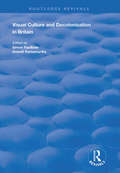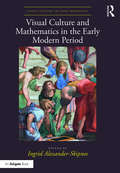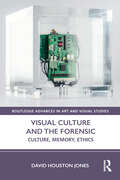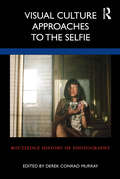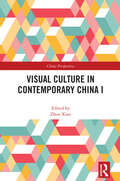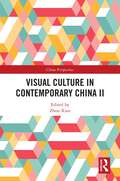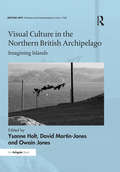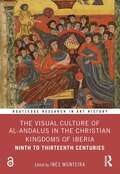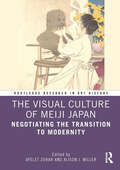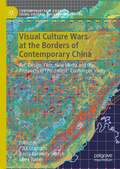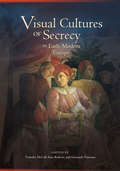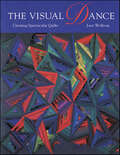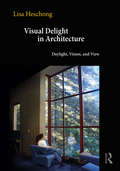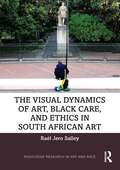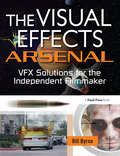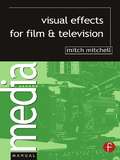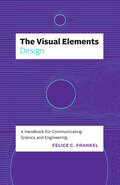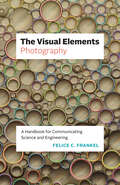- Table View
- List View
Visual Culture and Decolonisation in Britain (Routledge Revivals)
by Anandi RamamurthyFirst published in 2006, this volume provides the first in-depth analysis of the place of visual representations within the process of decolonisation during the period 1945 to 1970. The chapters trace the way in which different visual genres – art, film, advertising, photography, news reports and ephemera – represented and contributed to the political and social struggles over Empire and decolonisation during the mid-Twentieth century. The book examines both the direct visual representation of imperial retreat after 1945 as well as the reworkings of imperial and ‘racial’ ideologies within the context of a transformed imperialism. While the book engages with the dominant archive of artists, exhibitions, newsreels and films, it also explores the private images of the family album as well as examining the visual culture of anti-colonial resistance.
Visual Culture and Mathematics in the Early Modern Period (Visual Culture in Early Modernity)
by Ingrid Alexander-SkipnesDuring the early modern period there was a natural correspondence between how artists might benefit from the knowledge of mathematics and how mathematicians might explore, through advances in the study of visual culture, new areas of enquiry that would uncover the mysteries of the visible world. This volume makes its contribution by offering new interdisciplinary approaches that not only investigate perspective but also examine how mathematics enriched aesthetic theory and the human mind. The contributors explore the portrayal of mathematical activity and mathematicians as well as their ideas and instruments, how artists displayed their mathematical skills and the choices visual artists made between geometry and arithmetic, as well as Euclid’s impact on drawing, artistic practice and theory. These chapters cover a broad geographical area that includes Italy, Switzerland, Germany, the Netherlands, France and England. The artists, philosophers and mathematicians whose work is discussed include Leon Battista Alberti, Nicholas Cusanus, Marsilio Ficino, Francesco di Giorgio, Leonardo da Vinci and Andrea del Verrocchio, as well as Michelangelo, Galileo, Piero della Francesca, Girard Desargues, William Hogarth, Albrecht Dürer, Luca Pacioli and Raphael.
Visual Culture and Pandemic Disease Since 1750: Capturing Contagion (Science and the Arts since 1750)
by Marsha Morton Ann-Marie AkehurstThrough case studies, this book investigates the pictorial imaging of epidemics globally, especially from the late eighteenth century through the 1920s when, amidst expanding Western industrialism, colonialism, and scientific research, the world endured a succession of pandemics in tandem with the rise of popular visual culture and new media. Images discussed range from the depiction of people and places to the invisible realms of pathogens and emotions, while topics include the messaging of disease prevention and containment in public health initiatives, the motivations of governments to ensure control, the criticism of authority in graphic satire, and the private experience of illness in the domestic realm. Essays explore biomedical conditions as well as the recurrent constructed social narratives of bias, blame, and othering regarding race, gender, and class that are frequently highlighted in visual representations. This volume offers a pictured genealogy of pandemic experience that has continuing resonance. The book will be of interest to scholars working in art history, visual studies, history of medicine, and medical humanities.
Visual Culture and the Forensic: Culture, Memory, Ethics (Routledge Advances in Art and Visual Studies)
by David Houston JonesDavid Houston Jones builds a bridge between practices conventionally understood as forensic, such as crime scene investigation, and the broader field of activity which the forensic now designates, for example in performance and installation art, as well as photography. Contemporary work in these areas responds both to forensic evidence, including crime scene photography, and to some of the assumptions underpinning its consumption. It asks how we look, and in whose name, foregrounding and scrutinising the enduring presence of voyeurism in visual media and instituting new forms of ethical engagement. Such work responds to the object-oriented culture associated with the forensic and offers a reassessment of the relationship of human voice and material evidence. It displays an enduring debt to the discursive model of testimony which has so far been insufficiently recognised, and which forms the basis for a new ethical understanding of the forensic. Jones’s analysis brings this methodology to bear upon a strand of contemporary visual activity which has the power to significantly redefine our understandings of the production, analysis and deployment of evidence. Artists examined include Forensic Architecture, Simon Norfolk, Melanie Pullen, Angela Strassheim, John Gerrard, Julian Charrière, Trevor Paglen, Laura Poitras and Sophie Ristelhueber. The book will be of interest to scholars working in art history, visual culture, literary studies, modern languages, photography and critical theory.
Visual Culture Approaches to the Selfie (Routledge History of Photography)
by Derek Conrad MurrayThis collection explores the cultural fascination with social media forms of self-portraiture, "selfies," with a specific interest in online self-imaging strategies in a Western context. This book examines the selfie as a social and technological phenomenon but also engages with digital self-portraiture as representation: as work that is committed to rigorous object-based analysis. The scholars in this volume consider the topic of online self-portraiture—both its social function as a technology-driven form of visual communication, as well as its thematic, intellectual, historical, and aesthetic intersections with the history of art and visual culture. This book will be of interest to scholars of photography, art history, and media studies.
Visual Culture in Contemporary China
by Xiaobing TangExploring a wealth of images ranging from woodblock prints to oil paintings, this beautifully illustrated full-color study takes up key elements of the visual culture produced in the People's Republic of China from its founding in 1949 to the present day. In a challenge to prevailing perceptions, Xiaobing Tang argues that contemporary Chinese visual culture is too complex to be understood in terms of a simple binary of government propaganda and dissident art, and that new ways must be sought to explain as well as appreciate its multiple sources and enduring visions. Drawing on rich artistic, literary, and sociopolitical backgrounds, Tang presents a series of insightful readings of paradigmatic works in contemporary Chinese visual arts and cinema. Lucidly written and organized to address provocative questions, this compelling study underscores the global and historical context of Chinese visual culture and offers a timely new perspective on our understanding of China today.
Visual Culture in Contemporary China I (China Perspectives)
by Zhou XianAs the first volume of a two-volume set that examines the interaction between social transformation and visual culture in contemporary China, this book explores the visual construction of popular culture, avant-garde art, and grassroots media culture. Drawing on an approach of Marxist historic materialism and academic resources of sociology, communication, and art, this study of contemporary China’s visual culture emphasizes two inter-related aspects – the visual construction of society and the social construction of the visual. It seeks to unravel how visual culture is produced and constructed, as well as how it reflects the profound social transformation and reshapes people’s understanding and experience of modernization. In this volume, the contributors revisit popular culture, avant-garde art, and grassroots media culture in contemporary China, analyzing the visual image and representation, and visual culture’s role in social construction. In doing so, the book also reveals the cultural tension of contemporary China, in which the visual aspect figures prominently. This book will serve as an essential read for scholars and students of China studies and cultural studies, as well as all levels of readers interested in visual culture in contemporary China.
Visual Culture in Contemporary China II (China Perspectives)
by Zhou XianThe second in a two-volume series that explores the interplay between social transformation and visual culture in contemporary China, this book examines the profound changes in the cityscapes, visual regimes, and visual technologies that shape the aestheticization of everyday life.Drawing on an approach of Marxist historical materialism and interdisciplinary resources from sociology, communication, and art, this volume investigates three key aspects of visual culture in modern China: the transformation of urban landscapes and its impact on cultural autonomy and local identity; the development of visual regimes, focusing on public museums as sites for the construction of public visuality; and the role of visual technologies in reshaping everyday life, from the influence of television on traditional customs to the rise of internet subcultures.This title will provide valuable insights for scholars and students of Chinese, cultural, and urban studies, as well as readers interested in the ongoing visual transformation of contemporary Chinese society.
Visual Culture in the Northern British Archipelago: Imagining Islands (British Art: Histories and Interpretations since 1700)
by Ysanne Holt David Martin-Jones Owain JonesThis edited collection, including contributors from the disciplines of art history, film studies, cultural geography and cultural anthropology, explores ways in which islands in the north of England and Scotland have provided space for a variety of visual-cultural practices and forms of creative expression which have informed our understanding of the world. Simultaneously, the chapters reflect upon the importance of these islands as a space in which, and with which, to contemplate the pressures and the possibilities within contemporary society. This book makes a timely and original contribution to the developing field of island studies, and will be of interest to scholars studying issues of place, community and the peripheries.
The Visual Culture of al-Andalus in the Christian Kingdoms of Iberia: Ninth to Thirteenth Centuries (Routledge Research in Art History)
by Inés MonteiraThis book addresses the reception of Islamic visual culture by the northern Iberian kingdoms, by systematically comparing works of art from both sides and fleshing out their historical context.This study includes figurative and iconographic motifs, architectural forms, and even the spolia from constructions and Arabic inscriptions that were embedded in Christian buildings. The Islamic visual culture of al-Andalus was often transformed as it was recreated by Christian hands, bringing to the fore various nuances in the relationship between the two religious communities. Artistic transfer was conditioned by social coexistence between Christians and Muslims—both in the caliphate al-Andalus and in the northern realms—and military conflict. To approach the different ways in which Andalusi visual culture was received in the northern kingdoms, while embracing the vast diversity of case studies available, this book is divided into three thematic sections: Reinterpretation, Appropriation, and Artistic Transfers.This book will be of interest to scholars working in art history, visual culture, and medieval studies.
The Visual Culture of Meiji Japan: Negotiating the Transition to Modernity (Routledge Research in Art History)
by Ayelet Zohar Alison J. MillerThis volume examines the visual culture of Japan’s transition to modernity, from 1868 to the first decades of the twentieth century. Through this important moment in Japanese history, contributors reflect on Japan’s transcultural artistic imagination vis-a-vis the discernment, negotiation, assimilation, and assemblage of diverse aesthetic concepts and visual pursuits. The collected chapters show how new cultural notions were partially modified and integrated to become the artistic methods of modern Japan, based on the hybridization of major ideologies, visualities, technologies, productions, formulations, and modes of representation. The book presents case studies of creative transformation demonstrating how new concepts and methods were perceived and altered to match views and theories prevalent in Meiji Japan, and by what means different practitioners negotiated between their existing skills and the knowledge generated from incoming ideas to create innovative modes of practice and representation that reflected the specificity of modern Japanese artistic circumstances. The book will be of interest to scholars working in art history, Japanese studies, Asian studies, and Japanese history, as well as those who use approaches and methods related to globalization, cross-cultural studies, transcultural exchange, and interdisciplinary studies.
Visual Culture Wars at the Borders of Contemporary China: Art, Design, Film, New Media and the Prospects of “Post-West” Contemporaneity (Contemporary East Asian Visual Cultures, Societies and Politics)
by Paul Gladston Beccy Kennedy-Schtyk Ming TurnerThis edited collection brings together essays that share in a critical attention to visual culture as a means of representing, contributing to and/or intervening with discursive struggles and territorial conflicts currently taking place at and across the outward-facing and internal borders of the People’s Republic of China. Elucidated by the essays collected here for the first time is a constellation of what might be described as visual culture wars comprising resistances on numerous fronts not only to the growing power and expansiveness of the Chinese state but also the residues of a once pervasively suppressive Western colonialism/imperialism. The present volume addresses visual culture related to struggles and conflicts at the borders of Hong Kong, the South China Sea and Taiwan as well within the PRC with regard the so-called “Great Firewall of China” and differences in discursive outlook between China and the West on the significances of art, technology, gender and sexuality. In doing so, it provides a vital index of twenty-first century China’s diversely conflicted status as a contemporary nation-state and arguably nascent empire.
Visual Cultures of Secrecy in Early Modern Europe (Early Modern Studies #11)
by William Eamon Giancarlo Fiorenza Patricia Simons Maria Ruvoldt Henry Dietrich Fernández Allie Terry-FritschSecrets in all their variety permeated early modern Europe, from the whispers of ambassadors at court to the emphatically publicized books of home remedies that flew from presses and booksellers’ shops. This interdisciplinary volume draws on approaches from art history and cultural studies to investigate the manifestations of secrecy in printed books and drawings, staircases and narrative paintings, ecclesiastical furnishings and engravers’ tools. Topics include how patrons of art and architecture deployed secrets to construct meanings and distinguish audiences, and how artists and patrons manipulated the content and display of the subject matter of artworks to create an aura of exclusive access and privilege. Essays examine the ways in which popes and princes skillfully deployed secrets in works of art to maximize social control, and how artists, printers, and folk healers promoted their wares through the impression of valuable, mysterious knowledge.The authors contributing to the volume represent both established authorities in their field as well as emerging voices. This volume will have wide appeal for historians, art historians, and literary scholars, introducing readers to a fascinating and often unexplored component of early modern culture.
Visual Cultures of Secrecy in Early Modern Europe (Early Modern Studies)
by Giancarlo Fiorenza Patricia Simons William Eamon Maria Ruvoldt Henry Dietrich Fernández Allie Terry-Fritsch Lyle MasseySecrets in all their variety permeated early modern Europe, from the whispers of ambassadors at court to the emphatically publicized books of home remedies that flew from presses and booksellers’ shops. This interdisciplinary volume draws on approaches from art history and cultural studies to investigate the manifestations of secrecy in printed books and drawings, staircases and narrative paintings, ecclesiastical furnishings and engravers’ tools. Topics include how patrons of art and architecture deployed secrets to construct meanings and distinguish audiences, and how artists and patrons manipulated the content and display of the subject matter of artworks to create an aura of exclusive access and privilege. Essays examine the ways in which popes and princes skillfully deployed secrets in works of art to maximize social control, and how artists, printers, and folk healers promoted their wares through the impression of valuable, mysterious knowledge.The authors contributing to the volume represent both established authorities in their field as well as emerging voices. This volume will have wide appeal for historians, art historians, and literary scholars, introducing readers to a fascinating and often unexplored component of early modern culture.
The Visual Dance: Creating Spectacular Quilts
by Joen WolfromAn exciting journey into the world of design, The Visual Dance is a presentation of nature's design basics to help you build a foundation for your own style. This inspiring book clearly explains the how-tos of design for quilters and artists alike. Gallery of spectacular quilts, hundreds of detailed drawings, and 11 of Joen's original designs illuminate the discussion. Exercises guide you in understanding and using the design principles.
Visual Delight in Architecture: Daylight, Vision, and View
by Lisa HeschongVisual Delight in Architecture examines the many ways that our lives are enriched by the presence of natural daylight and window views within our buildings. It makes a compelling case that daily exposure to the rhythms of daylight is essential to our health and well-being, tied to the very genetic foundations of our physiology and cognitive function. It describes all the subtlety, beauty, and pleasures of well-daylit spaces and attractive window views, and explains how these are woven into the fabric of both our everyday sensory experience and enduring cultural perspectives. All types of environmental designers, along with anyone interested in human health and well- being, will fi nd new insights offered by Visual Delight in Architecture. The book is both accessible and provocative, full of personal stories and persuasive research, helping designers to gain a deeper understanding of the scientific basis of their designs, scientists to better grasp the real-world implications of their work, and everyone to more fully appreciate the role of windows in their lives.
The Visual Dictionary of Photography
by David PräkelThe Visual Dictionary of Photography provides clear definitions of key terms and concepts, backed up by hundreds of illustrative examples. Covering practical terms, it deals with the terminology of both digital and traditional photography. David Präkel has produced an invaluable resource for anyone interested in photography, lens-based media and related visual arts. This book serves not only to explain terms and words but also acts as a source of inspiration, encouraging exploration through understanding.Over 250 terms are explained and contextualised, with concise definitions accompanied by illustrations and examples taken from historical and contemporary photography.The dictionary covers analogue terms still in current usage as well as modern digital terminology such as Raw format and High dynamic range. It also defines a wide variety of practical terms, including ISO speed, Backlighting and Noise, as well as conceptual terms and photographic styles, ranging from Photojournalism to Distortion.
The Visual Dimension: Aspects Of Jewish Art
by Clare MooreThis book looks at art historical explorations, matters of archival legitimacy, the survival of fakes and forgeries and many other aspects of Jewish art. It commemorates the life and work of Isaiah Shachar through the medium of papers given at the first international conference on Jewish art.
The Visual Dynamics of Art, Black Care, and Ethics in South African Art (Routledge Research in Art and Race)
by Raél Jero SalleyThis book interprets relationships between art and ethics in the context of contemporary South African art.Nearly three decades after inaugurating political freedom in a democratic form, the infrastructure of South Africa faces palpable issues and challenges to the social fabric. The social tension involves painful struggles for decolonization and violent debates about the removal of colonial statues, change of colonial names, transformation of universities, and curriculum change. This book does critical work in art history, theory, criticism, and visual culture by looking from and looking after social differences to interpret the potential impact of contemporary media and mediation. Artists examined include Zanele Muholi, Mohau Modisekeng, Dineo Seshee Bopape, Hasan and Husain Essop, and Kemang Wa Lehulere.This book will be of interest to scholars working in art history, contemporary art, visual culture, art theory, ethics, aesthetics, philosophy of art, and African studies.
The Visual Effects Arsenal: VFX Solutions for the Independent Filmmaker
by Bill ByrneBuild your VFX arsenal with quick-access, step-by-step instruction on how to create today's hottest digital VFX shots. This essential toolkit provides techniques for creating effects seen in movies such as 300, Spiderman 3, Predator and others, with lessons on how-to:* splatter blood or digitally lop someone's arm off* create a scene with actors running from an explosion* create the "twin effect" (same actor, same location, 2 performances)* produce space-ship dog fightsOrganized in a 'cookbook' style, this allows you to reference a certain effect in the index and immediately access concise instructions to create that effect. Techniques are demonstrated in each of the most popular software tools- After Effects, Final Cut Studio, Photoshop, and Combustion are all covered. Brilliant, 4-color presentation provides inspiration and stimulating visual guidance to the lessons presented, while the downloadable resources contain project media files enabling you to put concepts learned into immediate practice.
Visual Effects for Film and Television (Media Manual Ser.)
by Mitch Mitchell* An invaluable insight into the use of visual effects in film and television* Fully illustrated with diagrams to show you step-by-step techniques* Covers visual effects processes from front-of-camera to post-production* Integrated approach to film, video and digital techniques* Redefines the rules of photography so that they can be broken for effects* Shows the line of development from the oldest to the newest processes* A must for cinematographers, editors, designers and students of VFX alike * Everything you need to know to plan and supervise visual effects shots* Essential reading for anyone working in commercials/advertising photography or effectsWritten by an experienced professional, this manual is the essential guide to understanding the principles and background of modern visual effects.Visual effects are at the forefront of a digital revolution in the film and video industry and are becoming more and more important to movie language. This book teaches the practical techniques and skills required to incorporate effects successfully into both film and television production.
Visual Effects for Indie Filmmakers: A Guide to VFX Integration and Artist Collaboration
by Shaina Holmes Laurie Powers GoingThis book provides independent filmmakers and VFX artists with tools to work collaboratively and effectively on their low-budget films. Experts Shaina Holmes and Laurie Powers Going define common VFX needs and demystify the process of incorporating VFX into all stages of production. The book covers every step of the process, including when to consider using VFX, basics of 2D and 3D methodology, budgeting, virtual production, on-set supervision, and more. It provides tips and tricks to common VFX questions, such as color management and file types, along with practical solutions for the production team while on-set working with VFX scenes. The incorporation of testimonials from indie filmmakers and VFX/post production professionals brings a voice to both sides of the table and provides real-world scenarios for the techniques described. The book offers realistic lower-budget alternative solutions to achieving big-budget vision. This book is ideal for students on a micro budget and independent filmmakers on low to mid budgets working with visual effects for photorealistic film, TV, and short-form projects.
The Visual Effects Producer: Understanding the Art and Business of VFX
by Susan Zwerman Charles FinanceFirst published in 2010. Routledge is an imprint of Taylor & Francis, an informa company.
The Visual Elements—Design: A Handbook for Communicating Science and Engineering (The Visual Elements)
by Felice C. FrankelWith insights and examples from designers at publications from Nature to the New York Times, an essential guide to creating figures and presentations. In this short handbook, award-winning science communicator Felice C. Frankel offers a quick guide for scientists and engineers who want to share—and better understand—their research by designing compelling graphics for journal submissions, grant applications, presentations, and posters. Like all the books in the Visual Elements series, this handbook is also a training tool for researchers. Distilling her celebrated books and courses to the essentials, Frankel shows scientists and engineers, from students to primary investigators, the importance of thinking visually. This crucial volume in the Visual Elements series offers a wealth of engaging design examples. Case studies and advice from designers at prestigious publications and researchers’ own before-and-after examples show how even the smallest changes—to color, type, composition, and layering—can greatly improve communication. Ideal for researchers who want a foothold for presenting and preparing their work for everything from conferences to publications, the book explains the steps for creating a concise and communicative graphic to highlight the most important aspects of research—and to clarify researchers’ own thinking. The resulting book is an essential element of any scientist’s, engineer’s, or designer’s library.
The Visual Elements—Photography: A Handbook for Communicating Science and Engineering (The Visual Elements)
by Felice C. FrankelFor novice or pro, primary investigator or postdoc, the essentials for photographing science and technology for journals, grant applications, and public understanding. Award-winning photographer Felice C. Frankel, whose work has graced the covers of Science, Nature,and Scientific American, among other publications, offers a quick guide for scientists and engineers who want to communicate—and better understand—their research by creating compelling photographs. Like all the books in the Visual Elements series, this short guide uses engaging examples to train researchers to learn visual communication. Distilling her celebrated books and courses to the essentials, Frankel shows scientists and engineers the importance of thinking visually. When she creates stunning images of scientific phenomena, she is not only interested in helping researchers to convey understanding to others in their research community or to gain media attention, but also in making these experts themselves “look longer” to understand more fully. Ideal for researchers who want a foothold for presenting and preparing their work for conferences, journal publications, and funding agencies, the book explains four tools that all readers can use—a phone, a camera, a scanner, and a microscope—and then offers important advice on composition and image manipulation ethics. The Visual Elements—Photography is an essential element in any scientist’s, engineer’s, or photographer’s library.
